At BarBend, we love training biceps. Who doesn’t? Big biceps signal to the world that you like to put in work at the gym.
That’s why our staff of industry veteran trainers, coachers, and educators have put our collective nose to the grindstone and built out this list of the best biceps exercises. You’ll also get more info on the muscle itself and learn how to incorporate biceps workouts into your routine.
16 Best Biceps Exercises
- Preacher Curl
- Hammer Curl
- Bayesian Curl
- Zottman Curl
- Concentration Curl
- Barbell Curl
- Chin-Up
- Incline Dumbbell Curl
- Spider Curl
- EZ-Bar Curl
- Drag Curl
- Seated Dumbbell Curl
- Cheat Curl
- Crucifix Curl
- Resistance Band Curl
- Cable Curl
Editor’s Note: The content on BarBend is meant to be informative in nature, but it should not be taken as medical advice. When starting a new training regimen and/or diet, it is always a good idea to consult a trusted medical professional. We are not a medical resource. The opinions and articles on this site are not intended for use as diagnosis, prevention, and/or treatment of health problems. They are not substitutes for consulting a qualified medical professional.
1. Preacher Curl
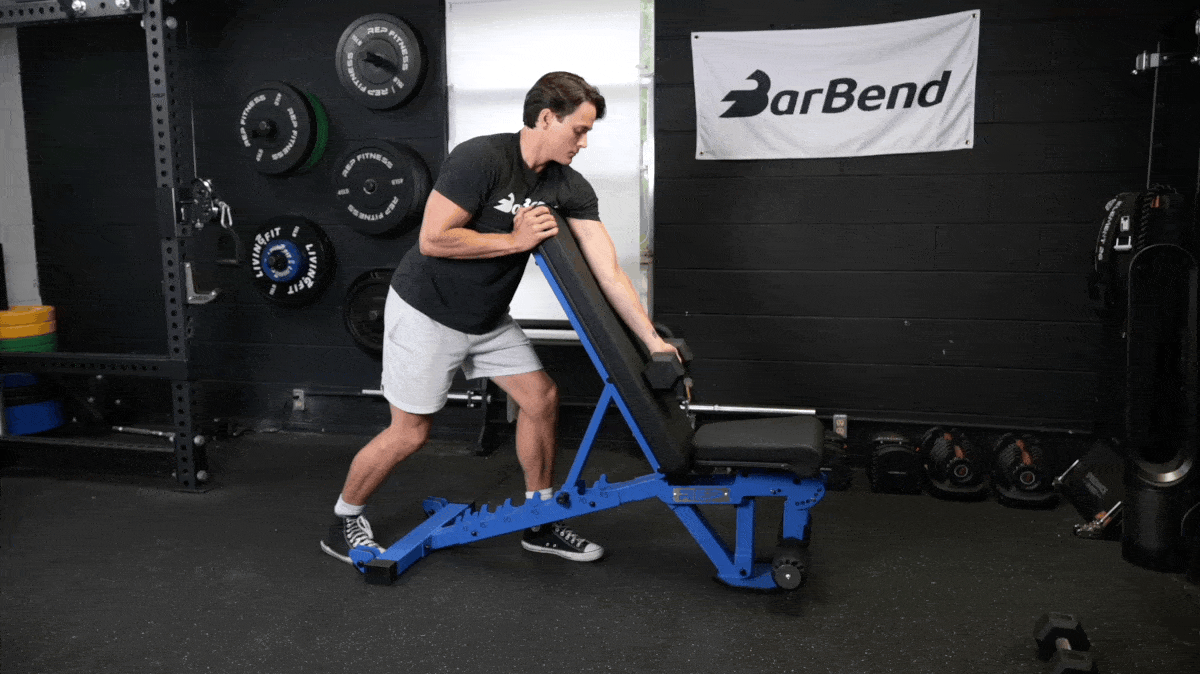
| Equipment Needed | Dumbbell, adjustable weight bench |
| Muscles Worked | Biceps |
| Sets & Reps | 3 x 8-10 |
Curling on a preacher bench lengthens the exercise’s effective range of motion. “Leaning your arm against an angled pad causes gravity to apply tension on the bottom half of the curl,” explains Dickson.
We think you can enhance the preacher curl further by working with one arm at a time — the single-arm preacher curl allows you to stretch your biceps out a bit more and target them individually for balanced development.
How To Do It
- Set an incline bench station to about 60 degrees if you don’t have access to a preacher bench.
- Drape one or both arms over the pad of the bench, ensuring your elbow is jammed snugly into the edge.
- Unfurl your arm and lower the weight slowly down until your elbow is almost fully straight.
- Reverse the motion and curl until your forearm is at least perpendicular to the surface you’re resting on.
Modifications
- Make It Easier: Adjust the angle of a weight bench seat as needed until you find something comfortable for your shoulders.
- Make It Harder: Try one-and-a-half reps at the bottom to enhance the tension in the stretched position and build more muscle.
2. Hammer Curl

[Related: The Best Bodyweight Biceps Exercises You Can Do]
| Equipment Needed | Dumbbells |
| Muscles Worked | Brachialis, biceps, forearms |
| Sets & Reps | 3 x 6-10 |
The hammer curl targets both the biceps brachii and brachialis, as well as the brachioradialis muscle on the forearm, for more overall thickness. This will be advantageous whether you’re looking to build out your physique or craft a strong grip to support massive deadlifts.
How To Do It
- Hold a dumbbell in each hand while standing upright with your feet under your hips.
- Turn your wrists so that they’re facing each other.
- Keep your arms tucked in at your sides and flex your elbows to curl the dumbbells up towards your shoulders. Lower them back down with control.
Modifications
- Make It Easier: You might try unwrapping your thumbs to make the move easier on your wrists.
- Make It Harder: Try pausing at the top of each rep when your elbow is at 90 degrees.
3. Bayesian Curl
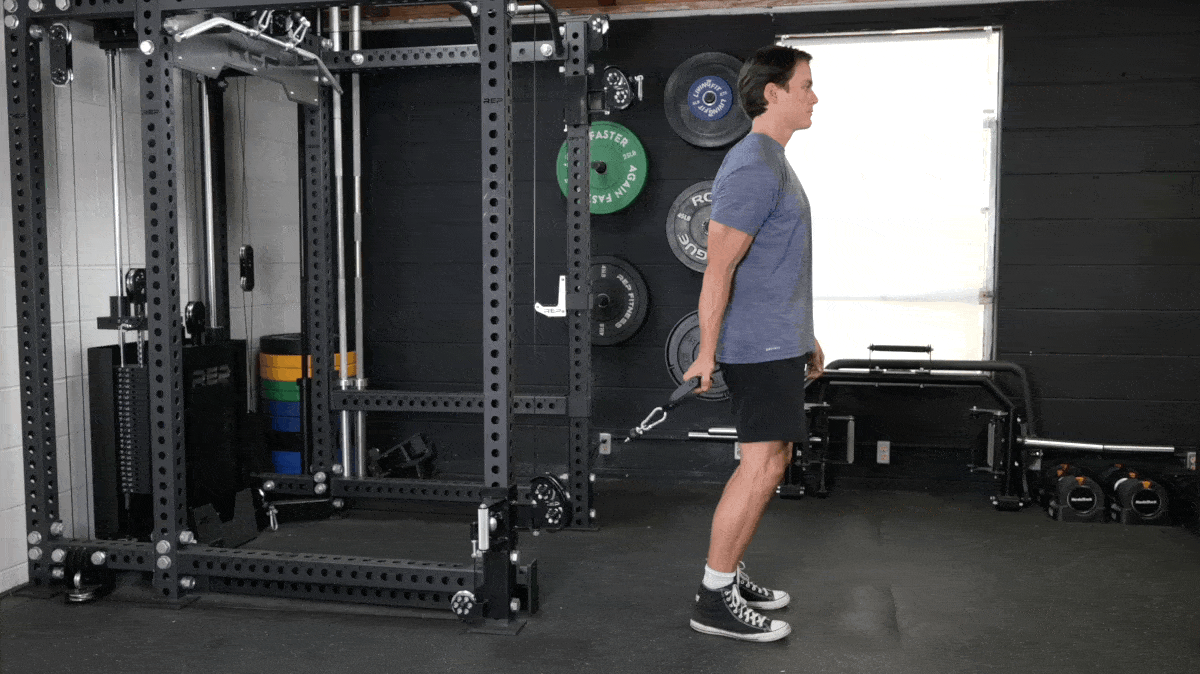
| Equipment Needed | Cable machine, D-handle attachment |
| Muscles Worked | Biceps |
| Sets & Reps | 2-3 x 12-15 |
To perform the Bayesian curl, you need to stand facing away from the cable tower. This setup allows you the same benefits of the incline dumbbell curl — a greater stretch due to a longer range of motion — coupled with the consistent resistance of the cables, which keeps tension on the muscle throughout the entire movement.
How To Do It
- Set the handles of the cable pulleys to the lowest setting and attach D-handles to each pulley. Pick up a handle in each hand.
- Tense your upper back and let your arms hang so they’re fully extended.
- Curl the weight without moving your shoulders. Hold the top of the movement before slowly lowering the handles with control.
4. Zottman Curl

[Related: How To Do the Reverse Curl for Biceps & Forearms]
| Equipment Needed | Dumbbells |
| Muscles Worked | Biceps, brachialis, forearms |
| Sets & Reps | 2-3 x 12-15 |
“The Zottman curl incorporates both supinated and pronated grips, it provides a comprehensive workout for the muscles involved in elbow flexion and forearm rotation,” Furr explains. “It’s a great addition to your arm training routine for building strength and size in these muscle groups.”
How To Do It
- Take hold of the dumbbells with your palms facing up. Curl as usual.
- Rotate your hands so that your palms are facing down once you reach the top of your rep.
- Lower the weights slowly and with control. When your arms lengthen, rotate your hands again so your palms are facing up.
Modifications
- Make It Easier: You can lower the weights with your palms in a neutral position as well rather than turning your hand over all the way.
- Make It Harder: Try doing this move with kettlebells, held by the handle, for a real forearm workout.
5. Concentration Curl
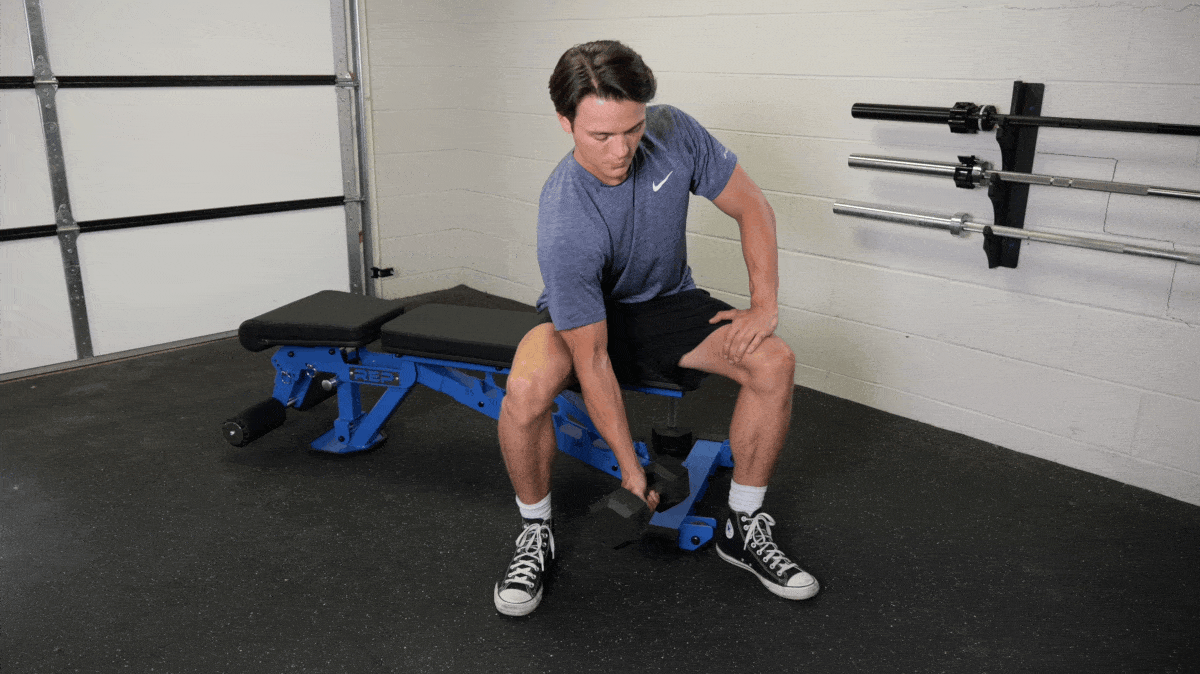
[Read More: Arnold Schwarzenegger’s Arm Workout, Explained and Remixed for All]
| Equipment Needed | Dumbbell, weight bench |
| Muscles Worked | Biceps |
| Sets & Reps | 2-3 x 10-12 |
The concentration curl is all about feeling your biceps work. Lifting with one arm lets you concentrate on engaging your biceps one at a time. Plus, you’ll allow your weaker arm to play catch-up with your dominant arm if there’s an imbalance at play.
How To Do It
- Sit on a weight bench with your feet set wide enough to allow your arm to hang in the middle, with your elbow resting on the inside of the thigh.
- Slowly curl a dumbbell upward at a controlled tempo, concentrating on contracting the biceps to move the load. At the top of the movement, flex as hard as possible.
- Lower the load slowly.
6. Barbell Curl
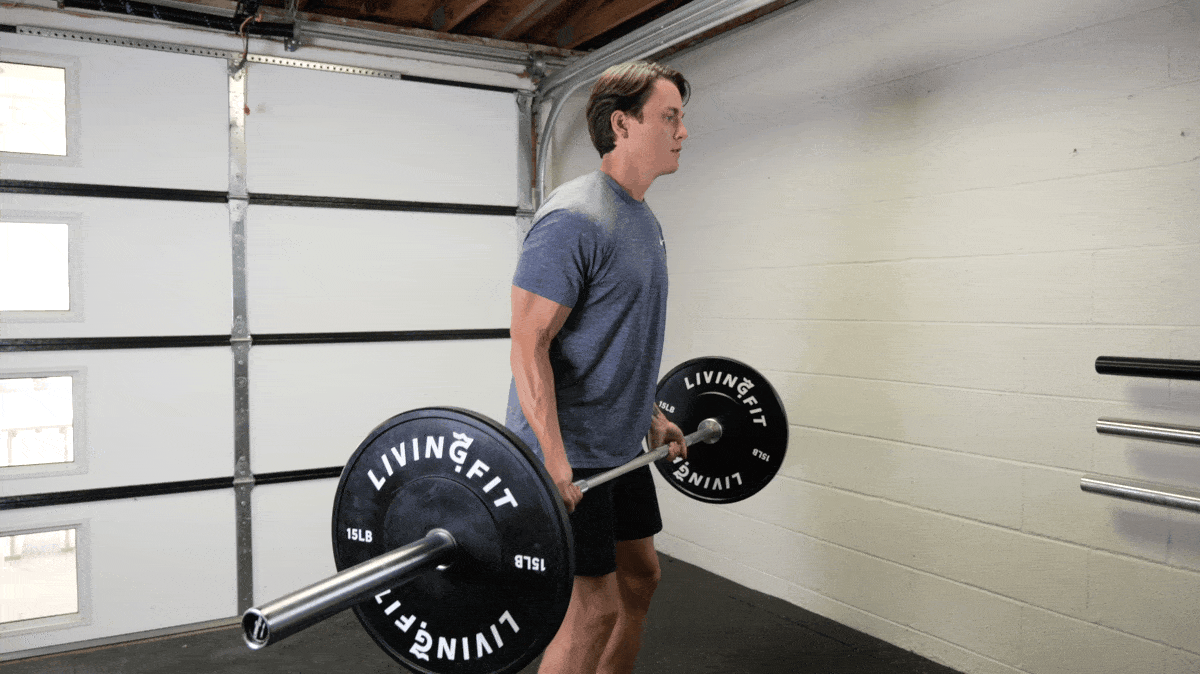
| Equipment Needed | Barbell, weight plates, fractional plates |
| Muscles Worked | Biceps, forearms |
| Sets & Reps | 3 x 6-8 |
The barbell curl is a classic biceps-builder. This exercise targets the biceps and can increase serious strength and size to the entire muscle when done correctly. You can curl more weight with the barbell curl than other curl variations as you lift a singular implement with both hands.
How To Do It
- Grab a barbell with an underhand grip, slightly wider than the shoulders.
- Pull your shoulders back into their sockets to expose the fronts of your biceps. Your elbows should be under your shoulder joints, or slightly in front by your ribs.
- Curl the barbell up using your biceps.
Modifications
- Make It Easier: Try a pre-loaded or plate-loaded cambered (EZ) bar to make this exercise more comfortable on your wrists.
- Make It Harder: Stand with your back against a wall to remove any possibility of swaying or cheating your reps with momentum.
7. Chin-Up
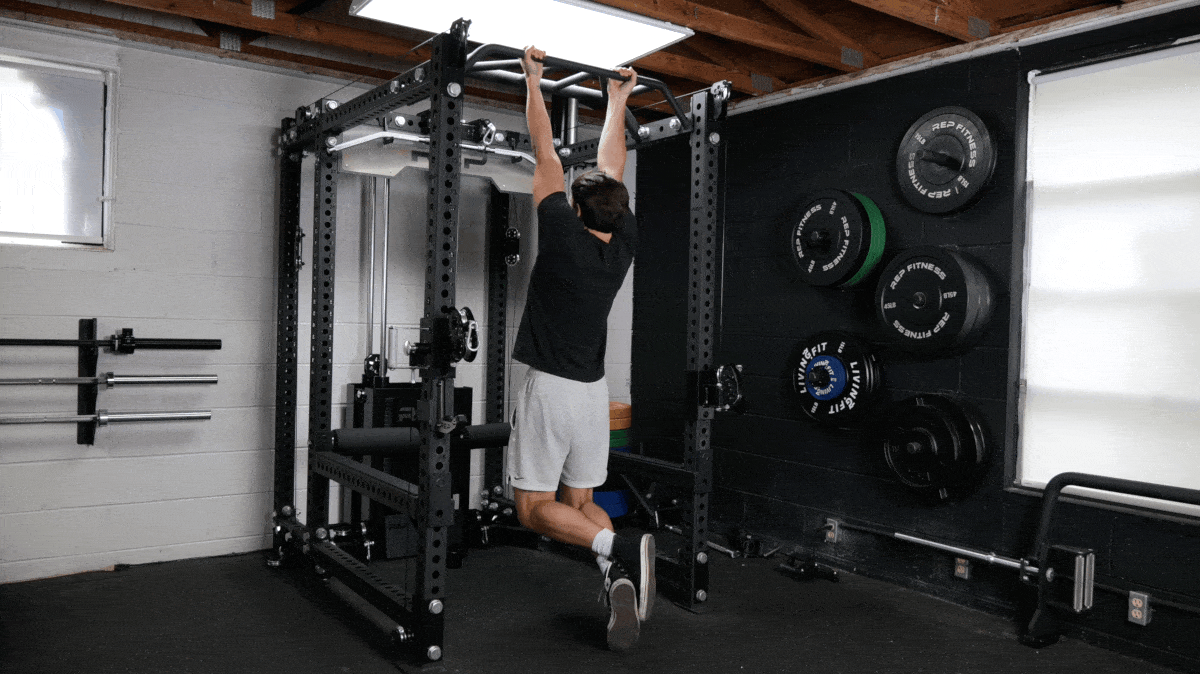
| Equipment Needed | Pull-up bar or power rack |
| Muscles Worked | Lats, biceps, rhomboids, core |
| Sets & Reps | 2-4 x 10-20 |
The chin-up can induce serious muscle growth of the biceps (and back) with nothing but a pull-up bar. If you have a door-mounted pull-up bar in your home gym, then that’s all you need to bang out sets of chin-ups. Since you’re working with your entire body weight, your biceps are exposed to loads heavier than you can lift with a barbell.
How To Do It
- Hang from a bar with palms facing you and your hands about shoulder-width apart or slightly wider.
- Squeeze your shoulder blades together from a dead hang.
- Pull your body up, making sure not to let your body fold inward until your chin is at or above the bar.
8. Incline Dumbbell Curl

| Equipment Needed | Dumbbells, adjustable weight bench |
| Muscles Worked | Biceps |
| Sets & Reps | 2-3 x 10-15 |
To perform the incline dumbbell curl, you’ll need to lie back on an incline gym bench. Curling from an incline takes the momentum out of the equation so that the lifter can’t cheat the weight up.
Secondly, curling with lengthened, extended arms creates a longer range of motion, ultimately making this curl variation more effective.
How To Do It
- Lie back on an incline bench, angled at about 60 degrees, with a dumbbell in each hand. Let your arms hang so they’re fully extended.
- Curl the weight up without moving your shoulders.
- Hold at the top of the movement for about a second, then slowly lower the dumbbells with control.
9. Spider Curl
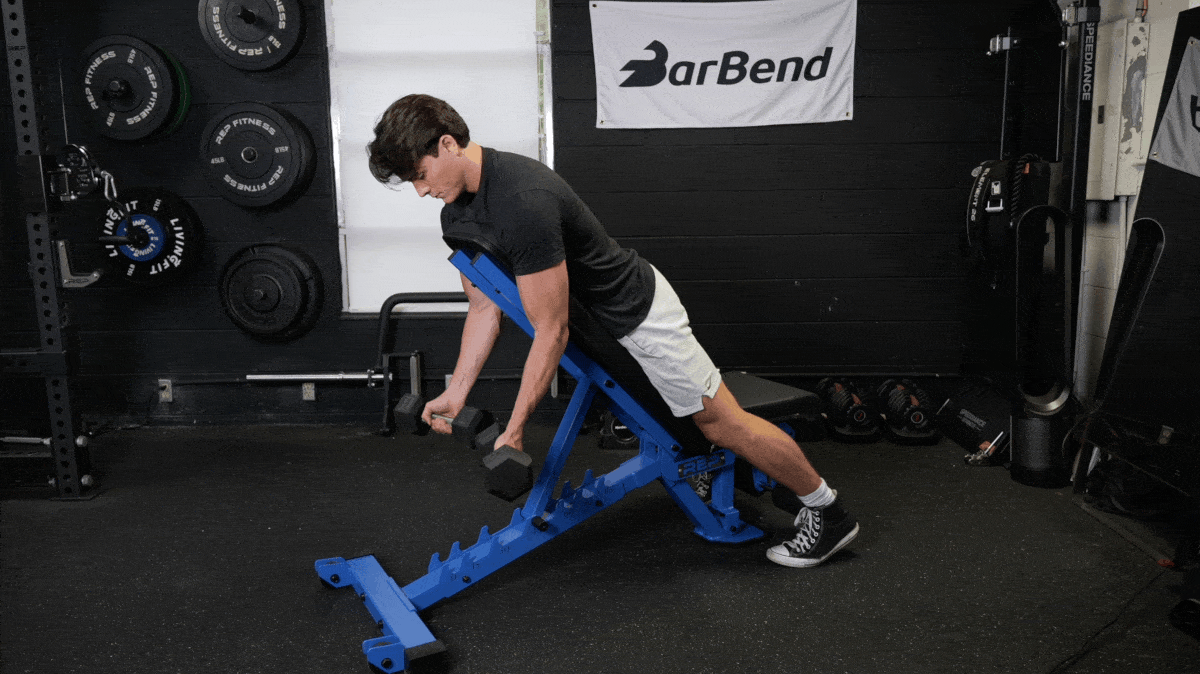
| Equipment Needed | Dumbbells, adjustable weight bench |
| Muscles Worked | Biceps |
| Sets & Reps | 2-3 x 12-15 |
If you’re afraid of the creature this biceps curl variation is named after, don’t worry — no arachnids need to join in the fun. The spider curl provides a chest support so you don’t sway back-and-forth as you curl, ensuring that your biceps alone do all the work.
How To Do It
- Set up an incline bench so that when you lie on it face down, your arms can just barely reach weights on the ground. (Use stable weight plates to raise the bench if needed.)
- Lie on the bench facing the ground, with your chest supported and your head extending over the top.
- Reach down to grab your chosen implement securely then reestablish a stable starting position.
- Curl the implement using only your biceps, avoiding any momentum.
10. EZ-Bar Curl
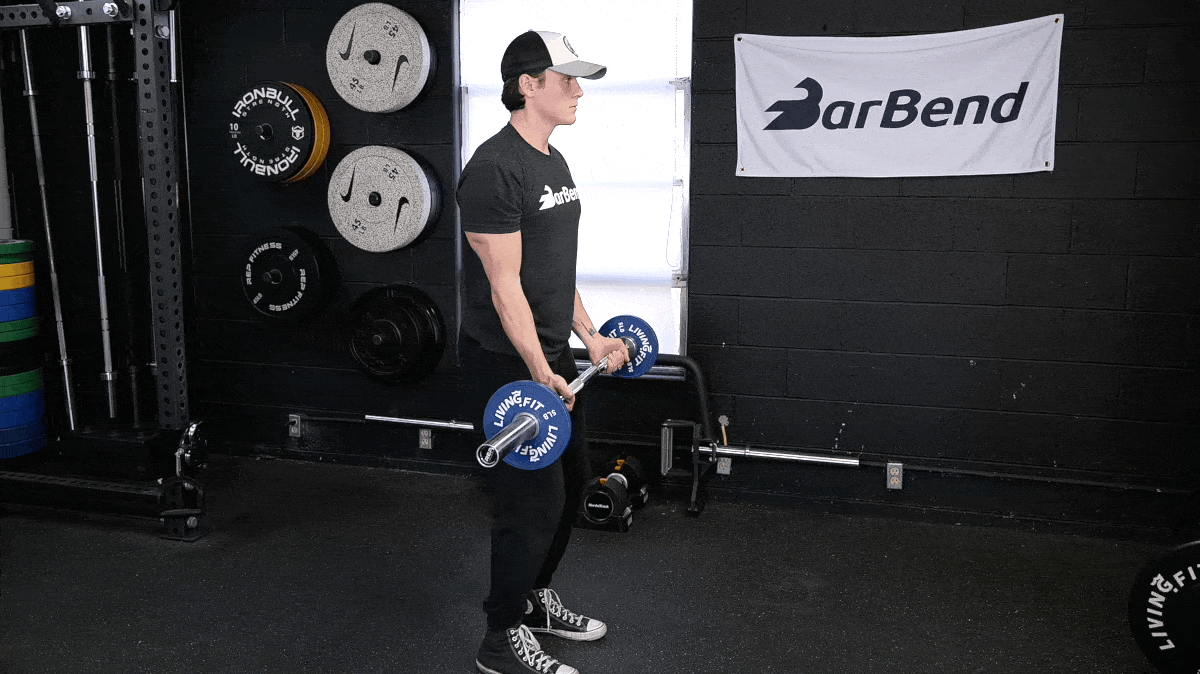
[Read More: The Best Biceps Stretches to Support Long-Term Arm Thickness and Strength]
| Equipment Needed | “EZ” or cambered barbell, weight plates, wrist wraps (optional) |
| Muscles Worked | Biceps |
| Sets & Reps | 3 x 8-10 |
“I’ve worked with clients who can’t perform straight-bar biceps curls due to wrist discomfort,” Dickson tells. “Grabbing a cambered bar is a convenient workaround.”
Sure, you can grind through the discomfort by using wrist wraps, or find a more practical solution, such as using an EZ-bar instead. The comfort of this move makes the EZ-bar curl one of the best bicep exercises for mass.
How To Do It
- Load an EZ-bar up with some plates or use just the bar itself, then stand upright with your feet under your hips.
- Brace your core and pin your upper arms to your sides tightly.
- Bend at the elbows, curling the bar up toward your chest, until your biceps fully contract.
11. Drag Curl

[Read More: The Best Arm Exercises for Major Muscle Growth]
| Equipment Needed | Barbell, weight plates, fractional plates; or dumbbells |
| Muscles Worked | Biceps |
| Sets & Reps | 3 x 12-15 |
Almost all biceps exercises involve pinning your upper arm to your torso and keeping it locked there for the duration of your set. However, the main benefits of the drag curl involve exploiting how your biceps insert onto your shoulder blade. By pulling your elbow backward behind you as you curl, you can stretch the biceps at one end and contract at another, creating unparalleled tension.
How to Do It
- Stand upright holding a barbell (or dumbbells) in your hands with a supinated grip.
- Curl the bar up and, simultaneously, pull your elbows back behind your torso.
- Use your biceps to guide the bar up your torso, making very gentle contact.
- Curl until you can’t pull your arms back any further, then reverse the motion.
Modifications
- Make It Easier: If your body obstructs range of motion in any way, you can also do this one with dumbbells.
- Make It Harder: Tie a resistance band around the middle of the shaft of the bar and stand with the other end under your feet to add some dynamic tension.
12. Seated Dumbbell Curl
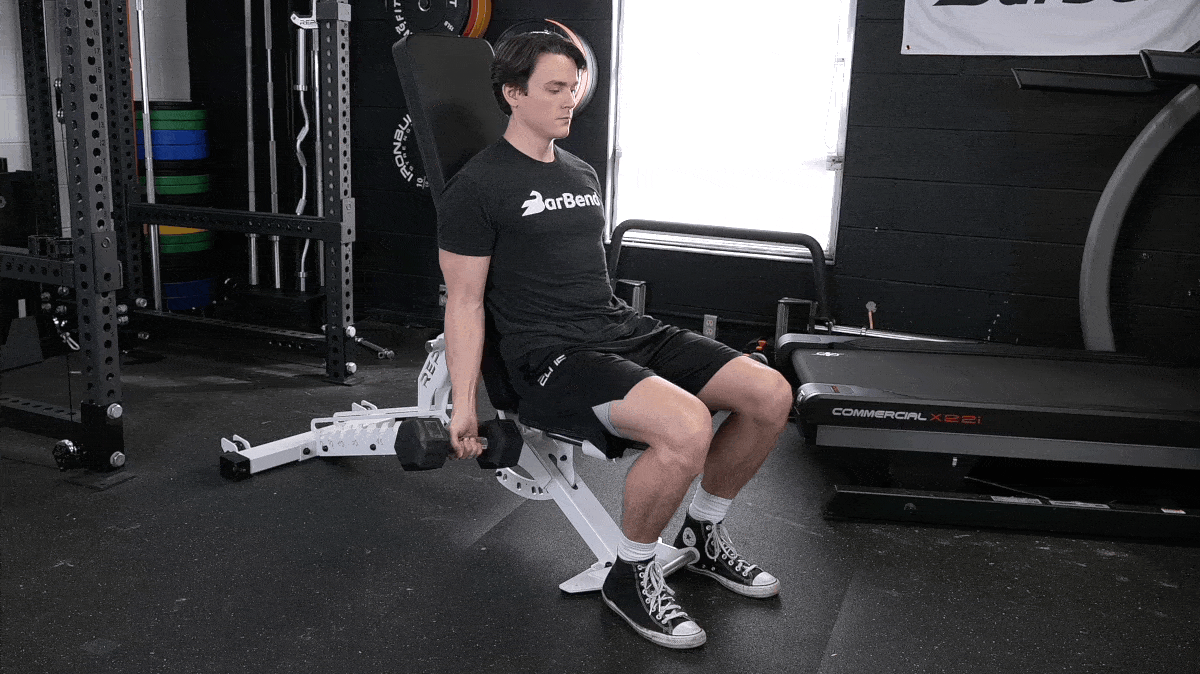
[Read More: 5 of the Best Dumbbell Arm Workouts for Strength, Size, and Time-Saving]
| Equipment Needed | Weight bench, dumbbells |
| Muscles Worked | Biceps |
| Sets & Reps | 3 x 6-10 |
Dumbbell curls are a great basic option for training your biceps. However, holding two weights at the same time can make you prone to swinging your body too much. Taking a seat on a bench reduces the amount of momentum you can generate to ensure you aren’t cheating the exercise form.
How To Do It
- Take a seat on the end of a flat or adjustable bench with your knees bent and your feet on the floor in front of you.
- Hold a dumbbell in each hand and pin your upper arms to your sides.
- Curl the weights up, either one at a time or simultaneously, until your biceps fully contract.
13. Cheat Curl
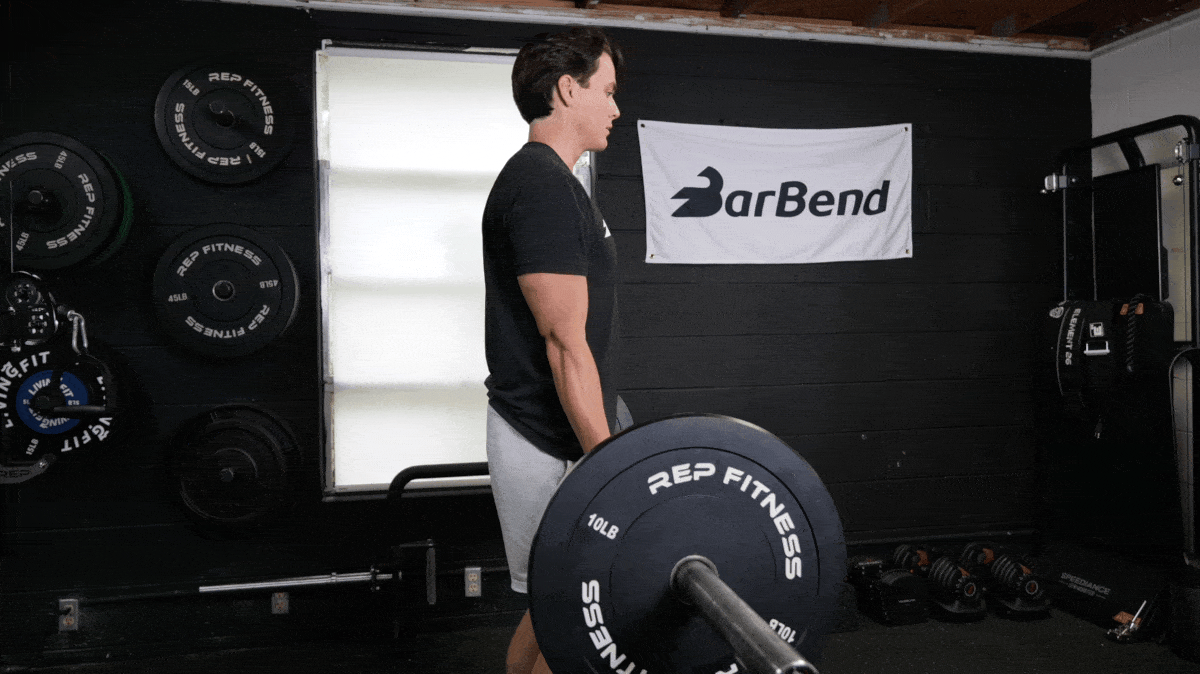
[Read More: The Most Effective Workout Splits, Created by Our Experts]
| Equipment Needed | Barbell, weight plates |
| Muscles Worked | Biceps |
| Sets & Reps | 3 x 5-8 |
Good form is integral to successful lifting, but that doesn’t mean you must color within the lines during every single biceps workout.
“By adding a bit of ‘body English’ to your standard barbell curl, you can lift heavier weights, create more mechanical tension, and emphasize the eccentric portion of the curl by lowering the bar slowly,” Dickson explains.
[Read More: The 7 Best Smart Home Gyms]
How To Do It
- Stand upright grasping a loaded bar as though you were going to perform a regular strict curl. Load up with a bit more weight than you’re used to.
- Initiate the cheat curl by hinging at the hips slightly and, as you bend your elbows, push your hips forward to give the bar a bit of kick.
- At the top, reverse the motion and fight the bar as you lower it down. Resist the weight, stretching your biceps out until your elbow straightens fully.
14. Crucifix Curl

| Equipment Needed | Cable station, D-handle attachment |
| Muscles Worked | Biceps |
| Sets & Reps | 1-2 x 12-20 |
The crucifix curl, named for the gymnastics pose it resembles, removes any support structure from your upper arm and aligns your biceps with the direction the cable is pulling. Curling from a high, extended arms position is thought to emphasize the short biceps head, which is what builds that coveted biceps peak. While this isn’t a shoulder exercise, you’ll get the added benefit of building a lot of shoulder stability in this position.
How To Do It
- Set a cable pulley to about shoulder height and attach a standard handle to the pulley.
- Stand between the pulleys and raise your arm to shoulder level, keeping your upper arm parallel to the ground.
- Curl the handle toward your head, then slowly lower the load back to the starting position.
Coach’s Tip: Think about twisting your fist and driving your pinky finger behind your head.
Modifications
- Make It Easier: You can do this move with a resistance band, or work one arm at a time.
- Make It Harder: Add some long-length partial reps at the end of each set.
15. Resistance Band Curl
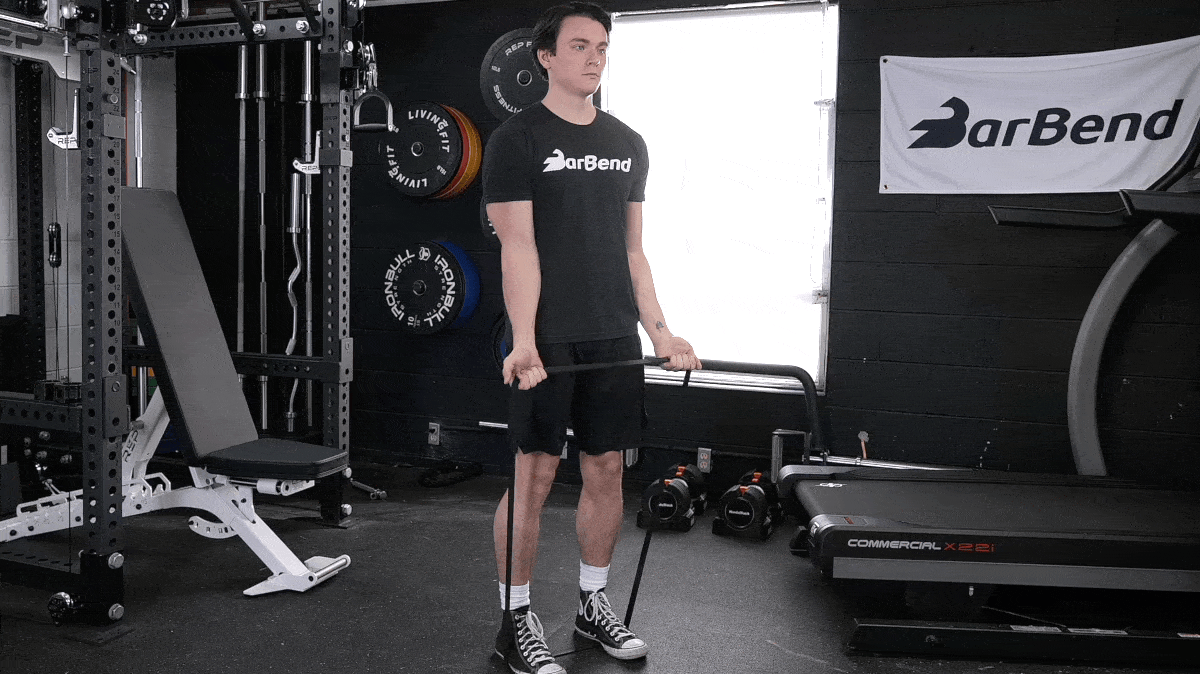
| Equipment Needed | Resistance band |
| Muscles Worked | Biceps, forearms |
| Sets & Reps | 1-2 x 15-20 |
If all you have access to are resistance bands, you can still use them to get a good arm workout in. Bands lack the loading potential of free weights or the consistency of cables, but on the other hand, they’ll fit into your backpack or gym bag. There aren’t many good biceps exercises with no equipment, but the banded biceps curl is certainly one viable option.
How To Do It
- Place a resistance band on the floor and step on it with both feet. Then, grab the handles if the band has them, or hold onto the band itself.
- Pin your arms to your sides and brace your core for stability.
- Curl the band upward as though it were a barbell or dumbbell.
16. Cable Curl

| Equipment Needed | Cable machine, straight bar attachment |
| Muscles Worked | Biceps |
| Sets & Reps | 2-3 x 8-12 |
Free weight biceps exercises are excellent, but they’re not the only thing you need. When you curl a dumbbell or barbell, the movement is hardest at the midpoint of the lift since the weight is furthest from the body. However, the cable biceps curl keeps tension on the muscle throughout the movement, as the weight stack you’re lifting is suspended throughout.
How To Do It
- Attach the desired handle to the pulley of a cable machine set to the lowest height.
- Grab the handle in both hands and take a few steps back so there’s constant tension on the cable (the weight stack should be elevated the entire time).
- Curl the bar up to your chest and then slowly lower it back down.
Modifications
- Make It Easier: You can also perform cable curls lying down on your back on the floor. This may reduce stress on your shoulders or lower back.
- Make It Harder: Wrap two towels around the bar or train with Fat Gripz to make the move more challenging on your grip strength.
5 Biceps Workouts To Try
Designing your biceps training is technically as simple as hitting the dumbbell rack and performing curl, after, curl, after curl. However, a good biceps workout should be more; more fun, more engaging, more challenging and, especially, more rewarding. If your arm day needs a touch-up, give any of these five workouts to pump up your sleeve-stretchers.
Biceps Workout for Mass
Here, you’ll strategically mix up the best biceps exercises for mass to create a major arm-builder. You’ll want to aim for 10-14 total sets per workout. Start with one arm workout per week, and then add another once your gains begin to plateau.
Also, you’ll want to rest between 90 seconds and two minutes between each set — long enough so that you can still push yourself on weight, but not too long that you’ll go cold.
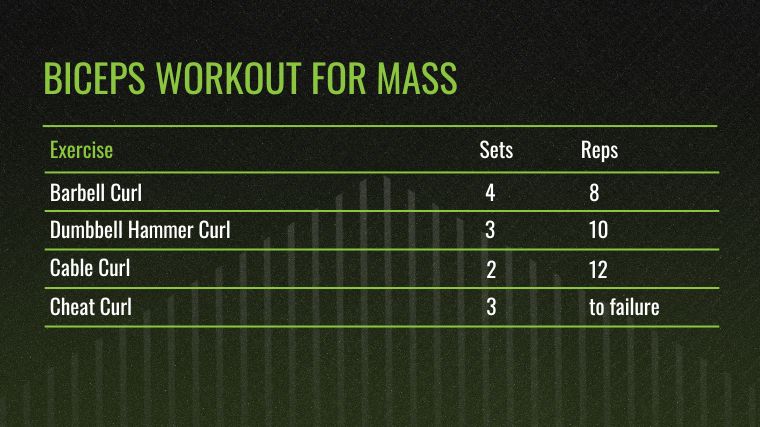
- Barbell Curl: 4 x 8
- Dumbbell Hammer Curl: 3 x 10
- Cable Curl: 2 x 12
- Cheat Curl: 3 sets to failure
Equipment Needed: Barbell, weight plates, fractional plates, cable machine, straight bar attachment, dumbbells, pull-up bar
Biceps Workout for Strength
When you’re training for strength, you’ll keep the volume lower — fewer reps and sets — but you’ll lift heavier weights. It’s also important to make sure the training volume isn’t too low, though, so it doesn’t diminish some of your strength and muscle growth.
For this reason, it’s recommended that you stick to a rep range between six and eight reps and do no more than three to four sets. To ensure adequate recovery between sets, rest for as long as two minutes.
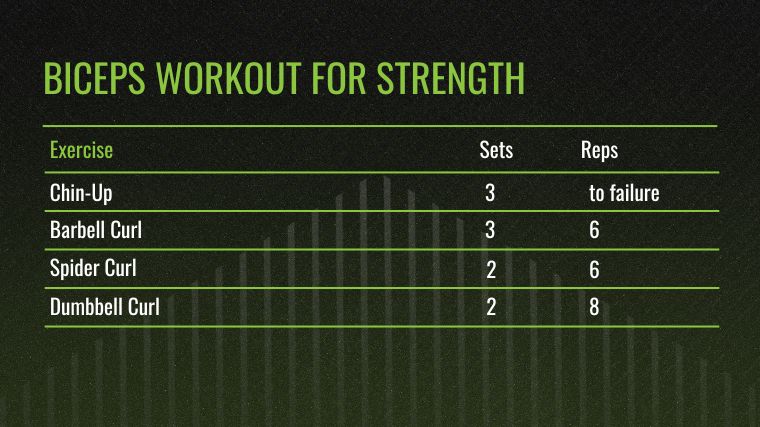
[Read More: The Best Dumbbell Exercises You Need for Muscle and Strength]
- Chin-Up: 3 sets to failure
- Barbell Curl: 3 x 6
- Spider Curl: 2 x 6
- Dumbbell Curl: 2 x 8
Equipment Needed: Pull-up bar, barbell, weight plates, fractional plates, dumbbells
Biceps Workout for Bodybuilders
For your biceps to look the most massive and ripped as possible, you as a bodybuilder should do as many reps, exercises, and sets as possible, without overtraining. You’ll also want to work with a variety of different equipment, ensuring that you hit your biceps thoroughly from all angles.

- Barbell Curl: 5 x 5
- Single-Arm High Cable Curl: 4 x 10
- Preacher Curl: 3 x 12
- Bayesian Cable Curl: 3 x AMRAP
Equipment Needed: Barbell, weight plates, fractional plates, cable machine, straight bar attachment, rope attachment, D-handle, dumbbells, adjustable weight bench
Biceps Workout for CrossFitters
The main objective for CrossFitters is performance; not having large arms. If you train for CrossFit, your biceps need to adequately assist you during exercises like pull-ups, rope climbs, on the rowing machine, and so on. The best way to develop your biceps, then, is to combine strength and endurance-focused training.
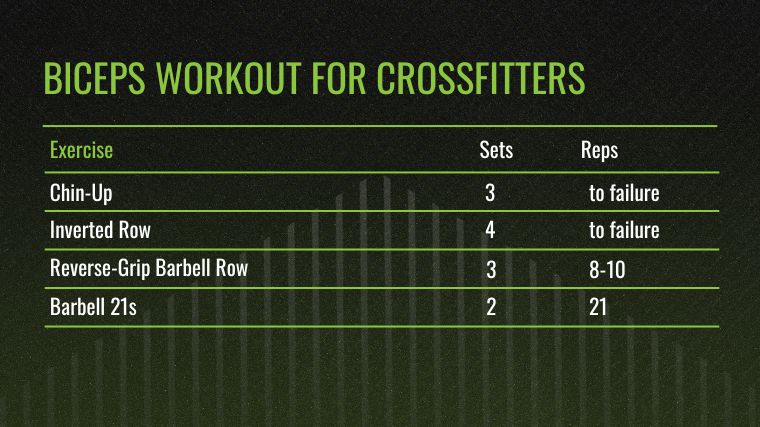
- Chin-Up: 3 sets to failure
- Inverted Row: 4 sets to failure
- Reverse-Grip Barbell Row: 3 x 8-10
- Barbell 21s: 2 x 21
Equipment Needed: Pull-up bar, barbell, safety spotter arms, squat rack, weight plates, fractional plates, dumbbells
Biceps Workout With Dumbbells
“I like doing most of my biceps curls with dumbbells,” Dickson remarks. “You can get ahold of a pair of dumbbells no matter where you train, and they allow you to work your arms separately along whatever range of motion is comfortable for you.”
If you feel similarly, you’re in luck. Here’s an expert-crafted biceps workout with dumbbells to try out on your next arm day:
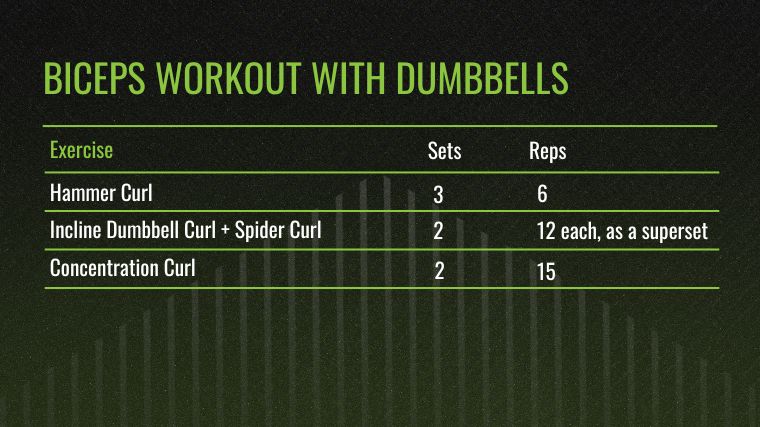
- Hammer Curl: 3 x 6
- Incline Dumbbell Curl + Spider Curl: 2 x 12, as a superset
- Concentration Curl: 2 x 15
What Muscles Make Up the Biceps
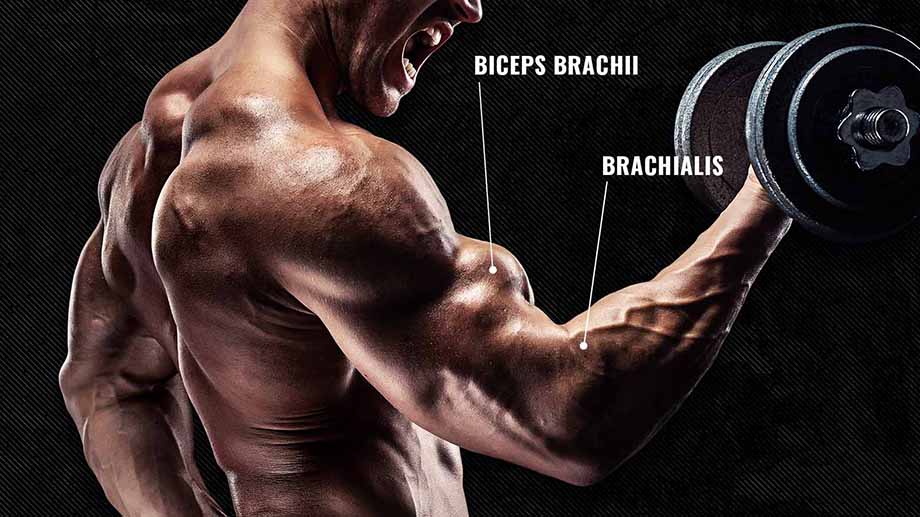
[Read More: Can You Really Build a Biceps Peak?]
The biceps are called brachii, which is Latin for “two-headed muscle of the arm”. There aren’t too many short head biceps exercises or long head biceps exercises, since the muscle works as a whole to bend your elbow. However, some free weight bicep exercises will bias one head more than another. Here’s a more detailed breakdown of the anatomy at play:
- Biceps Brachii: This two-headed muscle originates on your scapula and inserts onto your forearm. Its two heads perform mostly identical functions, but adjusting how you curl and the position of your upper arm will make an impact. (1)(2)
- Brachialis: This thick muscle sits underneath your biceps and on the outside of your humerus. The brachialis only crosses the elbow joint and doesn’t interact with your shoulder, making it the principal muscle for elbow flexion.
- Brachioradialis: This small muscle is considered part of your forearm, but acts as an assistive muscle during elbow flexion, particularly when you’re performing exercises with a pronated hand.
Benefits of Training Your Biceps
Your biceps are mirror muscles, but that’s not all they’re good for. When you perform bicep workouts, you strengthen your arms overall so you can better perform various tasks both inside and outside of the gym.
“The biceps can help with stabilizing the shoulder joint, especially during lifting or pulling movements. By strengthening the biceps, along with surrounding muscles, you can help to prevent injuries to the elbow and shoulder joints by providing better support and stability,” says Furr.
- Your biceps help you perform almost all back exercises. Strengthening your biceps will help you do more rows, pull-ups, and other compound exercises.
- Strong biceps can make it easier to carry out daily activities like picking your kids up, hoisting grocery bags into the bar, and more.
- You need to do biceps workouts if you want a balanced and complete physique. If you want bigger arms overall, half of that equation involves your biceps.
“Most people wrongly consider the biceps a vanity muscle only,” Dickson notes. “But you need strong biceps for most back exercises as well as during everyday movements like picking up an object from the floor or carrying something in front of you.”
Frequently Asked Questions
What is the most effective bicep exercise?
The most effective bicep exercise is the one you can stick with and progress over time. There’s no “mandatory” biceps exercise for mass or strength. If you’re in doubt, start with the basics, such as the barbell or dumbbell curl.
How many bicep exercises should I do per workout?
You’ll want to perform two or three biceps exercises per workout in most cases. Try to select movements that involve different equipment as well, such as one cable-based biceps exercise and one or more dumbbell biceps exercises.
Do push-ups work out biceps?
No. Push-ups are a chest and triceps exercise. Your triceps lie on the back of your upper arm and extend your elbow. Your biceps perform the opposite movement.
Should I work my biceps every day?
Like any muscle, your biceps need rest in order to grow. Muscle growth happens in the hours between your workouts, not during them. You can train your biceps two or three times per week, but make sure to leave at least 48 hours of rest between workouts.
References
- Schoenfeld, B. J., Ogborn, D., & Krieger, J. W. (2016). Effects of Resistance Training Frequency on Measures of Muscle Hypertrophy: A Systematic Review and Meta-Analysis. Sports medicine (Auckland, N.Z.), 46(11), 1689–1697.
- Tiwana MS, Charlick M, Varacallo M. Anatomy, Shoulder and Upper Limb, Biceps Muscle. [Updated 2020 Aug 11]. StatPearls Publishing; 2021 Jan.
Featured Image: mrbigphoto / Shutterstock